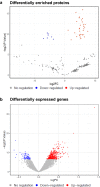The growth hormone receptor interacts with transcriptional regulator HMGN1 upon GH-induced nuclear translocation
- PMID: 37043098
- PMCID: PMC10409943
- DOI: 10.1007/s12079-023-00741-2
The growth hormone receptor interacts with transcriptional regulator HMGN1 upon GH-induced nuclear translocation
Abstract
Growth hormone (GH) actions are mediated through binding to its cell-surface receptor, the GH receptor (GHR), with consequent activation of downstream signalling. However, nuclear GHR localisation has also been observed and is associated with increased cancer cell proliferation. Here we investigated the functional implications of nuclear translocation of the GHR in the human endometrial cancer cell-line, RL95-2, and human mammary epithelial cell-line, MCF-10A. We found that following GH treatment, the GHR rapidly translocates to the nucleus, with maximal localisation at 5-10 min. Combined immunoprecipitation-mass spectrometry analysis of RL95-2 whole cell lysates identified 40 novel GHR binding partners, including the transcriptional regulator, HMGN1. Moreover, microarray analysis demonstrated that the gene targets of HMGN1 were differentially expressed following GH treatment, and co-immunoprecipitation showed that HMGN1 associates with the GHR in the nucleus. Therefore, our results suggest that GHR nuclear translocation might mediate GH actions via interaction with chromatin factors that then drive changes in specific downstream transcriptional programs.
Keywords: GHR; HMGN1; Mass spectrometry; Nuclear; Transcription factor.
© 2023. The Author(s).
Conflict of interest statement
None.
Figures




Similar articles
-
The basic route of the nuclear translocation porcine growth hormone (GH)-growth hormone receptor (GHR) complex (pGH/GHR) in porcine hepatocytes.Gen Comp Endocrinol. 2018 Sep 15;266:101-109. doi: 10.1016/j.ygcen.2018.05.002. Epub 2018 Jun 8. Gen Comp Endocrinol. 2018. PMID: 29890130
-
Morphogenic and tumorigenic potentials of the mammary growth hormone/growth hormone receptor system.Mol Cell Endocrinol. 2002 Nov 29;197(1-2):153-65. doi: 10.1016/s0303-7207(02)00259-9. Mol Cell Endocrinol. 2002. PMID: 12431808 Review.
-
Growth hormone signaling in human T47D breast cancer cells: potential role for a growth hormone receptor-prolactin receptor complex.Mol Endocrinol. 2011 Apr;25(4):597-610. doi: 10.1210/me.2010-0255. Epub 2011 Feb 10. Mol Endocrinol. 2011. PMID: 21310852 Free PMC article.
-
Growth hormone in vascular pathology: neovascularization and expression of receptors is associated with cellular proliferation.Anticancer Res. 2007 Nov-Dec;27(6B):4201-18. Anticancer Res. 2007. PMID: 18225592
-
Growth hormone receptor: structure and signal transduction.Eur J Endocrinol. 1995 Dec;133(6):654-9. doi: 10.1530/eje.0.1330654. Eur J Endocrinol. 1995. PMID: 8548048 Review.
Cited by
-
Pan-cancer Multi-omics Analysis Reveals HMGN1 as a Potential Prognostic and Immune Infiltration-associated Biomarker.Curr Med Chem. 2025;32(12):2440-2459. doi: 10.2174/0109298673268718231122103638. Curr Med Chem. 2025. PMID: 38310387 Free PMC article.
References
-
- Benjamini Y, Hochberg Y. Controlling the false discovery rate: a practical and powerful approach to multiple testing. J Roy Stat Soc: Ser B (methodol) 1995;57:289–300. doi: 10.1111/j.2517-6161.1995.tb02031.x. - DOI
Grants and funding
LinkOut - more resources
Full Text Sources
Miscellaneous

